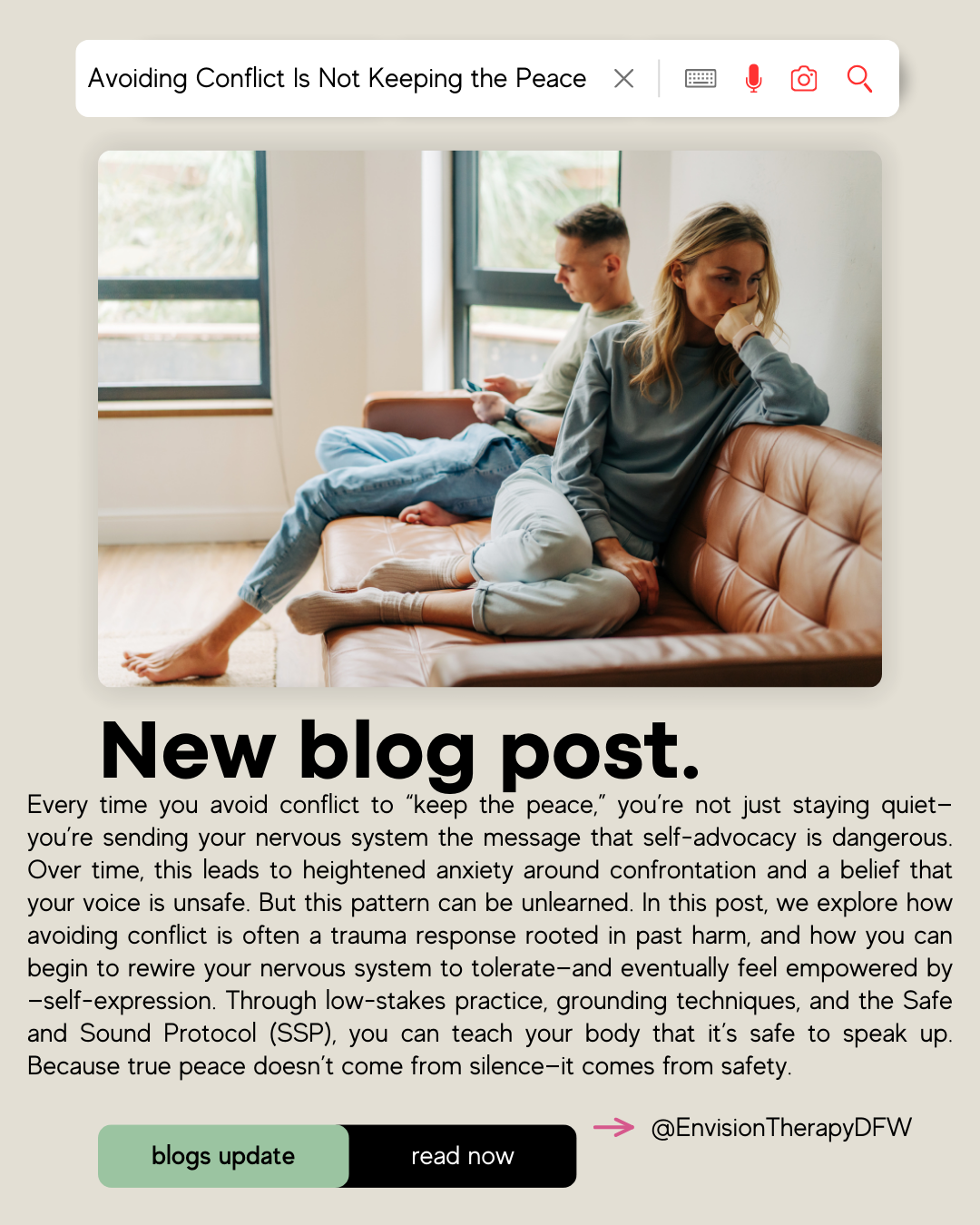It’s Teaching Your Body That Self-Advocacy Is Dangerous
What if avoiding conflict isn’t about keeping the peace, but convincing your body that self-advocacy is dangerous?
Have you ever walked away from a conversation feeling resentful, unsettled, or even physically tense—all because you didn’t say what you needed to say?
Maybe you smiled and nodded even though you were hurting.
Maybe you said, “It’s fine,” when it wasn’t.
Maybe you kept quiet because the idea of confrontation made your chest tighten, your stomach drop, or your voice disappear.
If that’s you, I want to tell you something you may have never heard before: Your comfort matters. Your needs are valid. Your voice deserves to exist—even in tension.
And yet, for so many of us, confrontation feels impossible.
Why? Because somewhere along the way, your nervous system learned that standing up for yourself wasn’t safe.
Not emotionally.
Not relationally.
Sometimes not even physically.
So now, every time you avoid confrontation to “keep the peace,” what you’re really doing is sending your nervous system this message:
“My comfort is a threat. My truth is dangerous.”
The Cost of Avoiding Confrontation
Avoidance Feels Safer—Until It Isn’t
Let’s get one thing clear: avoiding confrontation often comes from a deeply intelligent survival response.
You might have grown up in a home where speaking up led to yelling, guilt trips, or silence.
Maybe conflict always escalated, and there was no such thing as repair.
Or maybe your emotions were dismissed—labeled “dramatic,” “too much,” or “selfish.”
So you adapted.
You kept the peace.
You made yourself easy.
And it worked… for a while.
But here’s the problem:
Avoidance doesn’t actually keep the peace.
It keeps you uncomfortable so others don’t have to be.
And over time, that self-abandonment accumulates.
✔ Resentment builds.
✔ Communication breaks down.
✔ You feel invisible in your own relationships.
And worse? Your nervous system starts to equate self-advocacy with threat.
You don’t just avoid conflict—you feel unsafe inside your body when it arises.
How the Nervous System Learns to Fear Conflict
From a neurobiological standpoint, your brain is always scanning for danger—and not just physical danger. Emotional threat counts too.
If past conflict led to harm, embarrassment, disconnection, or shame, your nervous system took notes.
Now, when you even think about setting a boundary or expressing discomfort, your body might react before you even speak:
- Tight throat
- Racing heart
- Shaky hands
- Nausea
- Emotional shutdown
This isn’t weakness. This is trauma physiology.
You’re not “bad at confrontation”—you’re wired to avoid it.
But the beautiful thing about the brain? It’s neuroplastic. Which means it can learn something new.
Practice Low-Stakes Confrontation
You don’t have to start by having a huge confrontation with a loved one. In fact, you shouldn’t.
The key is starting small, in spaces that feel low-risk and manageable.
Here’s how to begin:
- Notice your pattern.
- When do you swallow your truth?
- What types of people or dynamics make you freeze?
- Pick a low-stakes moment to speak up.
- Correct a wrong order at a restaurant.
- Ask for a preference in a group.
- Say, “Actually, I disagree,” in a casual convo.
- Use grounding techniques.
- Deep belly breaths
- Pressing your feet into the floor
- Softening your shoulders before speaking
- Celebrate the effort, not the outcome.
- Whether or not it went perfectly doesn’t matter.
- The win is that you showed up.
Every small act of expression tells your body:
“It’s safe to take up space.”
Your Brain Learns Through Safety and Repetition
Each time you advocate for yourself and the world doesn’t end, your nervous system relaxes.
Each time you set a boundary and someone respects it, your brain records it as evidence of safety.
This is how healing works—not in one big, cathartic showdown, but in small, repeated experiences of safety and self-trust.
Over time, what once sent you into panic becomes manageable.
And eventually, confrontation doesn’t feel like a threat.
It feels like self-respect.
Need Help Rewiring Your Nervous System? Try SSP
If your body still reacts to confrontation like it’s a lion in the room, even after you know it’s safe, that’s not your fault.
That’s your nervous system doing its job.
One powerful way to help your body feel safe again?
The Safe and Sound Protocol (SSP).
SSP is a neuroscience-backed listening therapy designed to: ✔ Calm the body’s fight-flight-freeze responses
✔ Regulate emotional reactivity
✔ Rebuild tolerance for connection and confrontation
✔ Strengthen your sense of internal safety
It’s not talk therapy. It’s nervous system therapy.
Comment “SSP” below to learn more about how it can support your journey back to safe self-expression.
Final Thoughts: Your Voice Deserves Safety
Avoiding conflict may have kept you safe in the past.
But now? It’s keeping you from your truth.
Your nervous system doesn’t need to fear your voice.
It just needs to experience it as safe again.
That takes time.
That takes patience.
But it’s absolutely possible.
And you don’t have to do it alone.
Ready to Reclaim Your Voice Without Panic?
If you’re tired of shrinking yourself to keep the peace, we’re here to help you change that pattern—safely, gently, and at your own pace.
Click here or reach out to schedule a consultation with one of our therapists trained in trauma-informed, nervous system-based care.
You deserve to speak up and still feel safe.
TL;DR
Avoiding confrontation may feel like peacekeeping, but it teaches your nervous system that your voice is dangerous. Over time, this creates a fear response around self-advocacy. The way forward? Start with low-stakes conflicts, use grounding tools, and help your body learn that standing up for yourself is safe. Tools like the Safe and Sound Protocol (SSP) can support nervous system regulation and help you reclaim your voice without overwhelming your system.
Tags: confrontation avoidance, trauma healing, nervous system regulation, people-pleasing, Safe and Sound Protocol, conflict anxiety, self-advocacy, fawning response, trauma therapy, emotional healing

